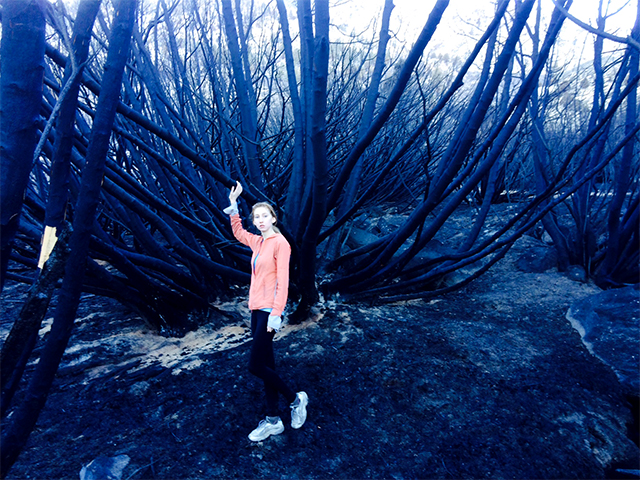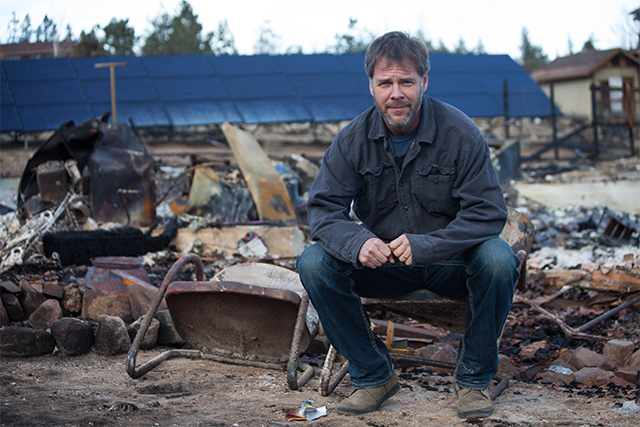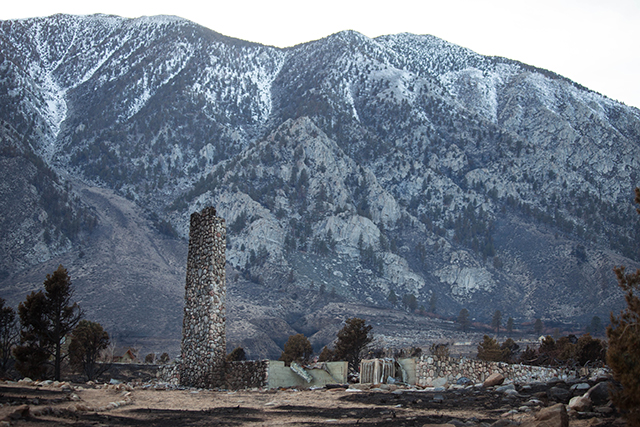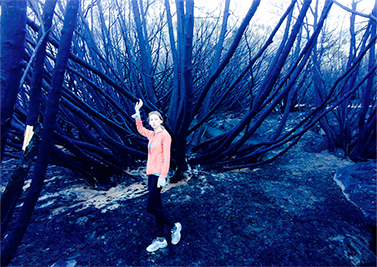
Photo courtesy of Kendra Atleework.
By Kendra Atleework
For four years California has been in drought. This winter is the warmest in state history, and in the Sierra Nevada mountains snowpack is at a record low. On the night of Friday, February 6, 2015, a firestorm known as the Round Fire, fueled by winds gusting to 112 mph, moved through high desert brush into a remote mountain community called Swall Meadows. The fire destroyed forty homes and 7,000 acres of sage, bitterbrush, piñon, and pine, at a time of year when this mountainside is usually buried under snow. I have evacuated Swall Meadows for wildfire before, as a child. But that was in July. Now, California’s wildfire season runs an average of seventy-six days longer than it used to, and no one knows what the summer will bring.
touch
When the evacuation order is lifted we drive back up the mountain and I find a small piece of singed window screen in the dirt not far from our front door. This bit of screen was blown onto our property from a nearby house as it burned. The screen lies by the ashy toe of my sneaker; it’s the size of a silver dollar, black and stiff, and when I brush the edges fibers flake away.

Most likely it came from Chris’s house, which used to sit in a grove of Jeffrey pines above ours on the mountain. Or it could have come from Bob and Rosemary’s place, which sat across Foothill Road and a little to the west. Both of these houses were within 300 feet of ours and both have been reduced to a foot or so of ash, which feels like baby powder between my fingers.
sight
When granite burns it becomes some other kind of rock; instead of crumbling like all the granite I’ve ever seen it falls in slices like bread. When cars burn, their windows slop down over their doors. When a mountain burns it stands blue and stark and smoldering, eerily bare of snow.
Fire melts copper piping and shatters concrete foundations so that as our neighbors sift the ash for pieces of jewelry they find themselves digging into dirt. Above the shattered foundations a few objects remain, stripped to their brick or metal skeletons: exercise bikes, washer-dryer sets, chimneys, flagpoles. Bob and Rosemary buy a new flag and hang it at half mast.

The piece of screen survived because it broke free from a burning house, and this tells us something about the randomness of fire. Bob is a volunteer firefighter; his house was painted and caulked and sealed and cleared of vegetation. When I picture the corner of Foothill and Swall Meadows Road I still see the little green house—tidy, set back on its dark asphalt driveway. It burned. About half of the houses in Swall Meadows burned. My father calls our house a tinderbox. One spark, he says. One ember. Our house is built from raw redwood and around it are clustered blue spruce and Jeffrey pine and cottonwood and a small apple orchard. The driveway is long and unpaved; it is difficult to turn around in or back out of. It is probably too narrow for a fire engine to approach.
In the night, from the highway, it looked as if all of Swall Meadows was burning: that nothing would be left behind. In the morning, rumors filtered down from the mountain before we were allowed in to see with our own eyes. Our house stands. As the fire moved from one to the next, little pieces, like this bit of screen, like a blue flake from a solar panel and a scrap of blackened fabric, drifted around these red wooden walls and settled in the sage.
smell
The piece of screen smells like sulfur. I smell like sulfur. My neighbors smell like sulfur. Nobody here can figure out why burned houses stink of sulfur. Staff from the county health department drive around carrying fliers about toxicity and telling everyone to wear respirators as they dig through the debris. If the wind picks up it will scatter this ash—as fine as flour—all over the valley.

Photo courtesy of Kendra Atleework.
I help my neighbors sift through the ash for several days. I run my clothes through the washing machine and when I lift the lid the machine reeks like a hot springs and I have to run it again, this time with vinegar. I can’t get the burned smell off my hands and when I ask my father’s friend, who builds houses, why I still smell like sulfur—ask him what component of carpet or drywall or mattress could have burned down to reek like this—he lets me put my gray fingers to his face, and he says he doesn’t know, but the smell reminds him of fireworks.
sound
The wind used to hum through this piece of screen. I know because my own windows look down over the valley and up over the mountain and the wind still moves through them. When I was a kid I used to press my nose against the screen in my bedroom window and smell its ropey smell and peer up at the dark spine of the mountain. I can still do this but my neighbors can’t. My neighbors can’t open and close their windows or repair a hole in the screen that the cat has clawed; or complain about replacing a screen when the wind and the sun have turned it brittle, here where the wind blows often and the sun has shone hotter this winter than winters before. Because the same wind grew strong, so strong it pushed my father to his knees as he watched from the highway as the fire spread up the mountain. The wind seized a white and spiny bitter brush with a solid trunk three inches thick and whipped it around in circles. Another neighbor watched this. From his front porch, he watched the wind spin the bitter brush as he struggled to stand. Then he saw the line of flame come up out of a coulee and move towards the westernmost houses, which in photographs taken after dark blaze like yellow stars. He wrapped his favorite painting in canvas, threw it in the back of his truck, and drove away.


